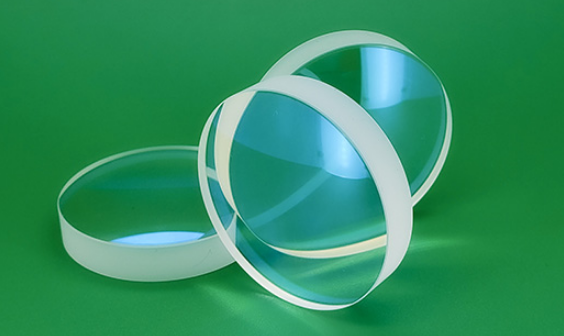Introduction to the Plano-Convex Lens
Nov. 18, 2024
When building an optical system, understanding the plano-convex lens, or singlet spherical lens, is essential. Whether the application is industrial, pharmaceutical, defense, or CO2 laser-based, the plano-convex lens plays a crucial role in focusing, collecting, and collimating light.
A plano-convex lens is an optical element designed to focus light to a single point. The “plano” side refers to the flat surface, while the “convex” side is outwardly curved. In contrast, a plano-concave lens (which we'll discuss another time) features an inwardly curved surface.
The outward curvature of the convex side results in a positive focal length. A positive focal length means the light converges at a point on the opposite side of the lens from the object.
To enhance the focusing properties of the plano-convex lens, anti-reflective (AR) coatings are often applied. Stray light reflections can weaken the beam's intensity, so these coatings, which can be broadband (covering a wide range of wavelengths) or designed for specific wavelengths, help ensure more efficient focusing.
Various Applications for Plano-Convex Lenses
Imaging
Plano-convex lenses are widely used in imaging devices such as telescopes, microscopes, and binoculars. The unique asymmetry, with one flat (plano) side and one curved (convex) side, helps reduce spherical aberration, particularly in applications where the object and image are at different distances.
As an object approaches the lens from the plano side, the inverted image grows in size and appears farther away. At twice the focal length, the image remains inverted but appears the same size as the object. Once the object passes the focal point, the image becomes virtual and appears magnified on the same side of the lens as the object.
In essence, like all positive lenses, the plano-convex lens magnifies objects when positioned between the object and the observer's eye. These lenses can be designed with varying curvature, and the greater the curvature (or angle) of the lens, the shorter the focal length. This is due to light waves refracting at steeper angles relative to the lens's optical axis.
Treating Farsightedness
Farsightedness, or hyperopia, is a condition where the eye struggles to focus on nearby objects. While distant objects are clear, focusing on close-up objects requires a different lens shape that a farsighted eye lacks. To view nearby objects clearly, a lens with a high degree of curvature is needed.
Plano-convex lenses are commonly used in eyeglasses to correct this condition. In a farsighted eye, the distance between the eye's lens and the retina is shorter than normal, causing the focal point to fall behind the retina. Convex lenses in eyeglasses help by increasing the light refraction, effectively reducing the focal length.
These lenses bend the light before it enters the eye, thereby decreasing the image distance. By starting the refracting process earlier, the light is focused correctly on the retinal surface, allowing the wearer to see nearby objects clearly.
Typically, crown glass or high-performance plastics are used for these lenses to ensure optimal clarity and durability.
Laser Cutting
Plano-convex lenses are frequently used in laser cutting, particularly for materials like steel and other thick substances. These lenses enhance the laser's cut width, improving its ability to penetrate the material. In such cutting applications, plano-convex lenses offer a greater depth of field, resulting in a non-tapered edge for a cleaner and more precise cut.
For optimal performance, the materials used in these lenses must have a high damage threshold to withstand the intense focus of the laser beam.
ZnSe (zinc selenide) and germanium are commonly chosen for this purpose. ZnSe has low absorption, allowing it to transmit visible light while withstanding high-power lasers, making it ideal for demanding applications. Germanium, with its ability to handle lower power lasers, is widely used in the semiconductor industry.
Specs of Plano-Convex Lens
CLZ Optics provides a range of various plano-convex lenses with varying materials, focal lengths, diameters as well as optical coatings. You can check our website for our full and expanding offering of optical lenses.






















